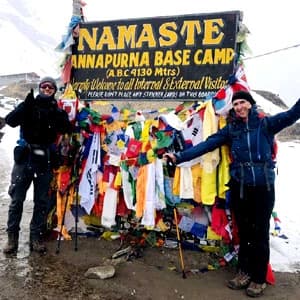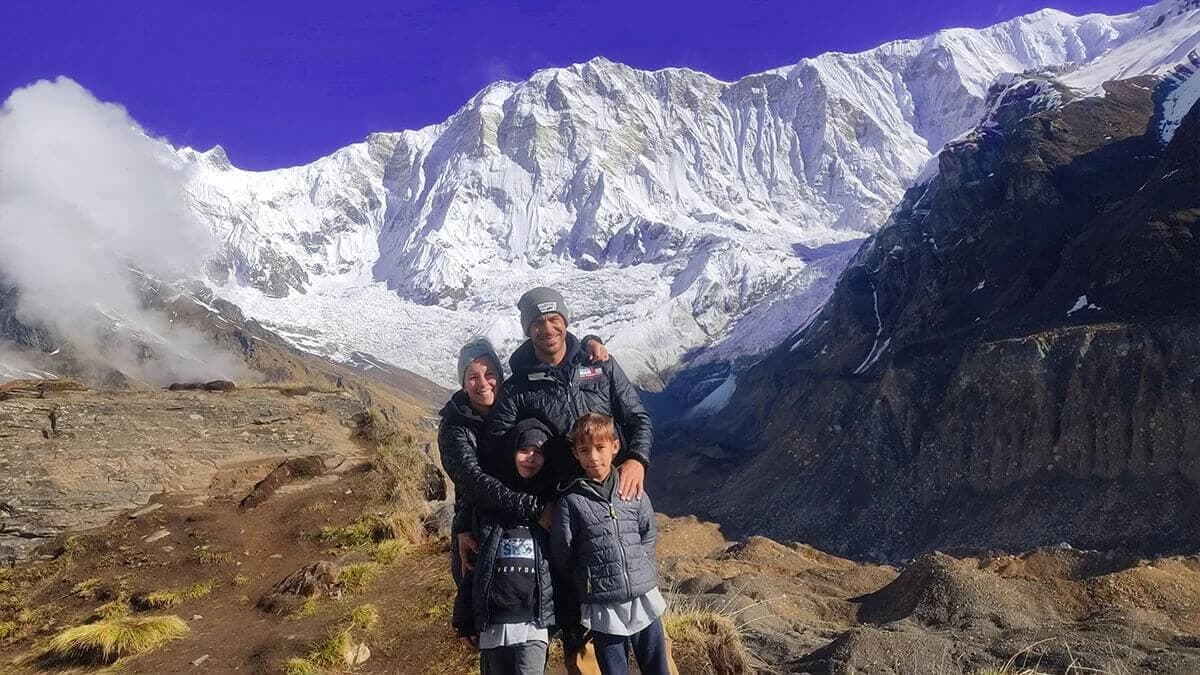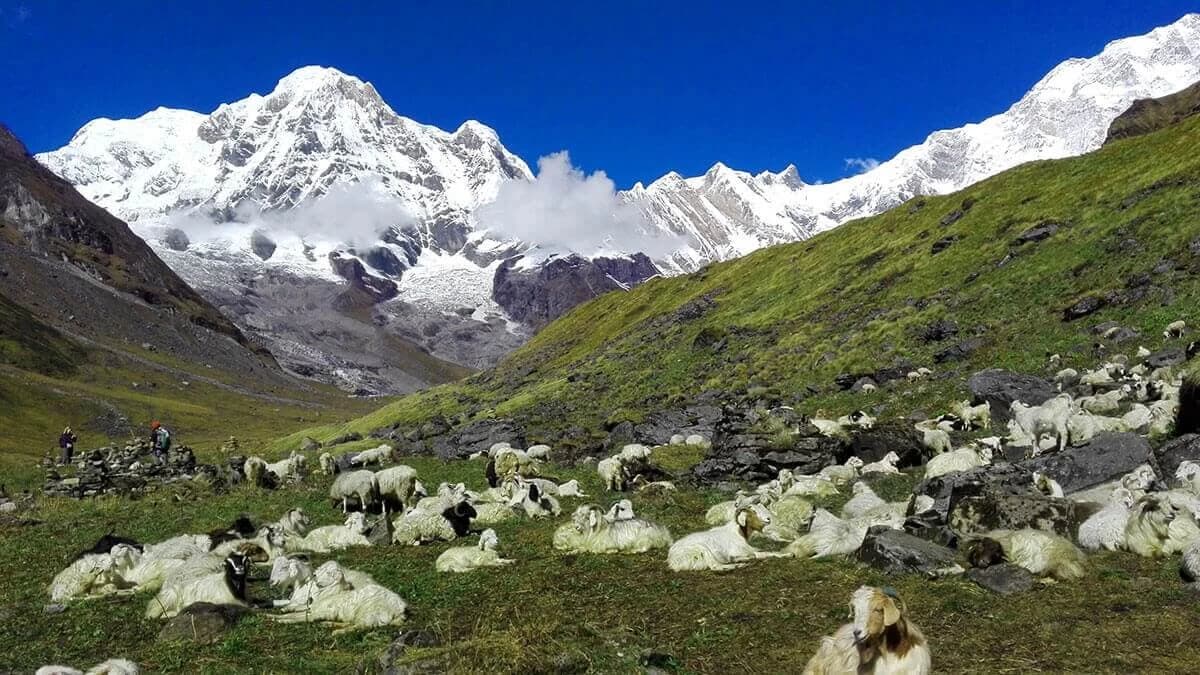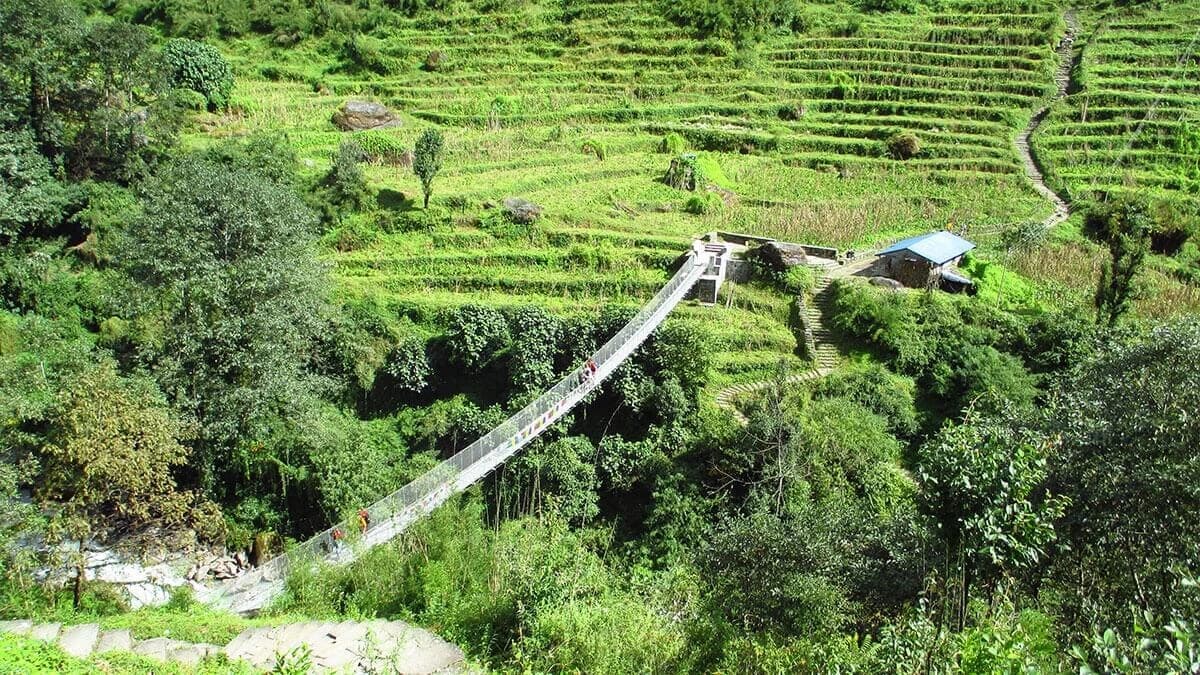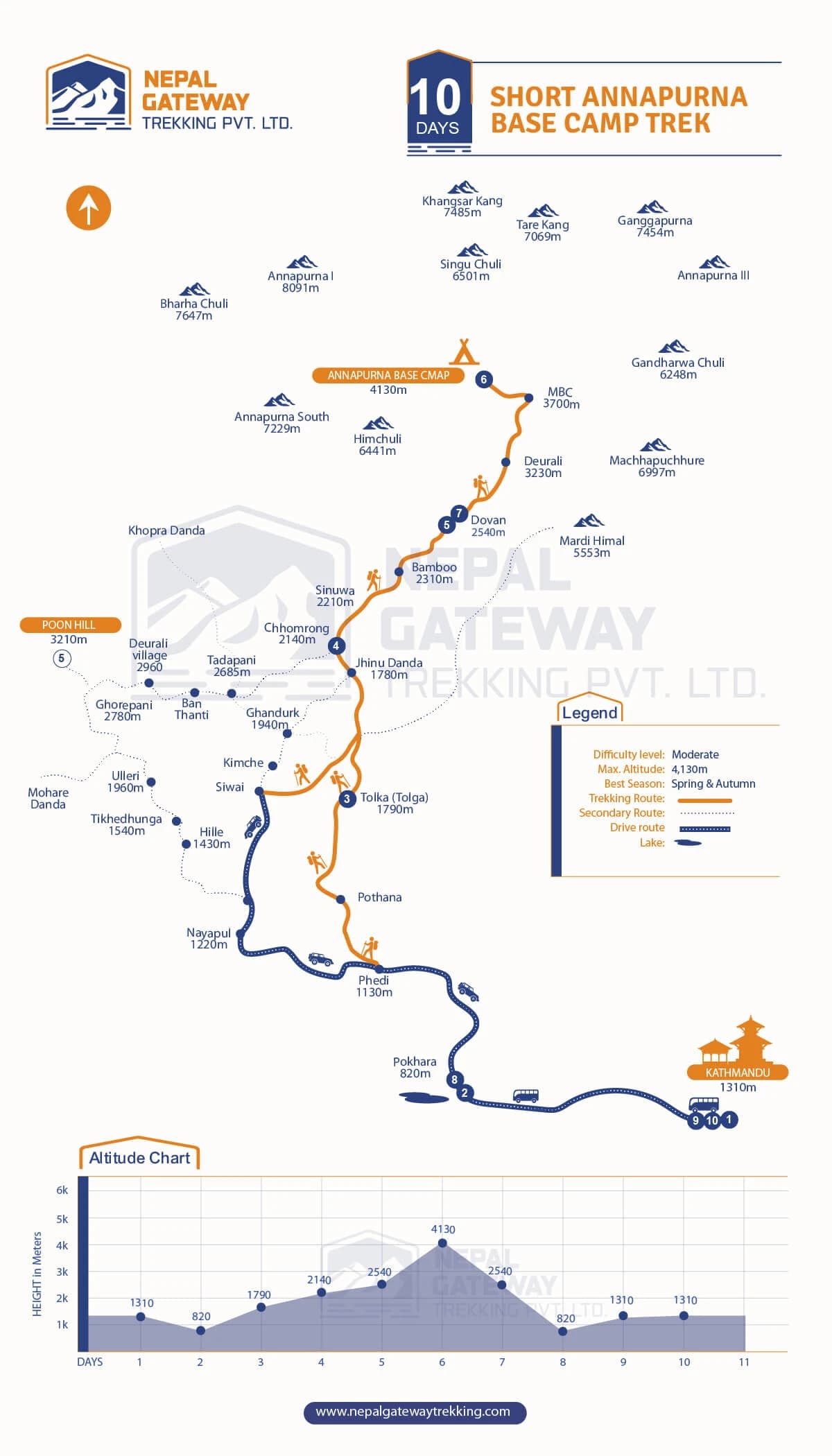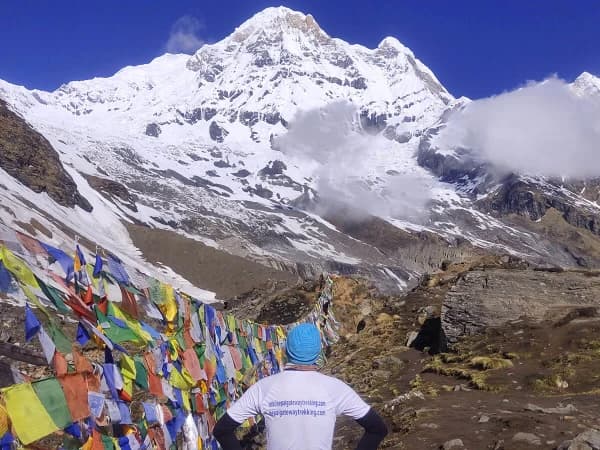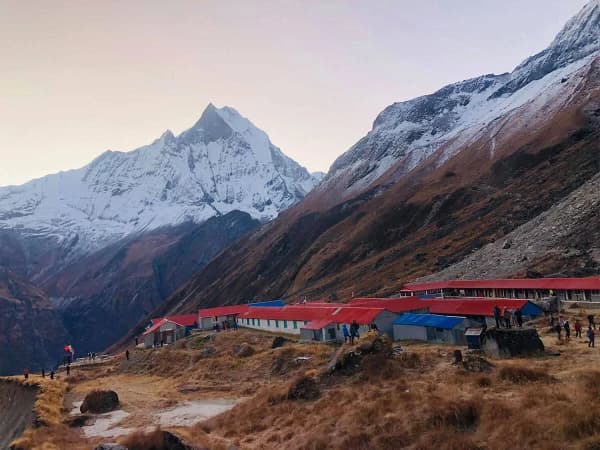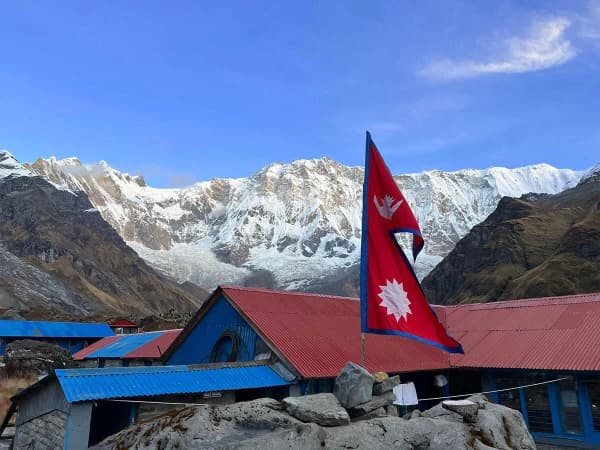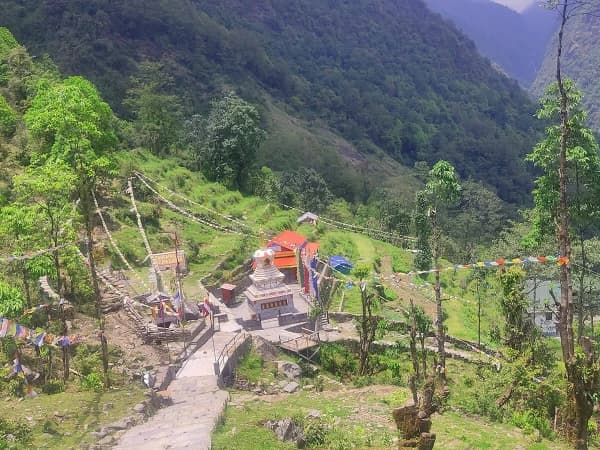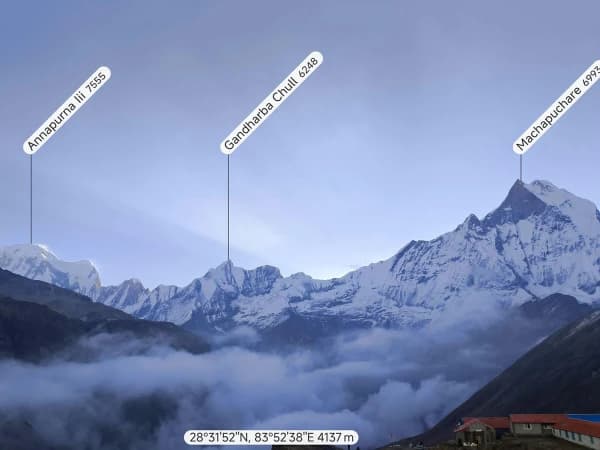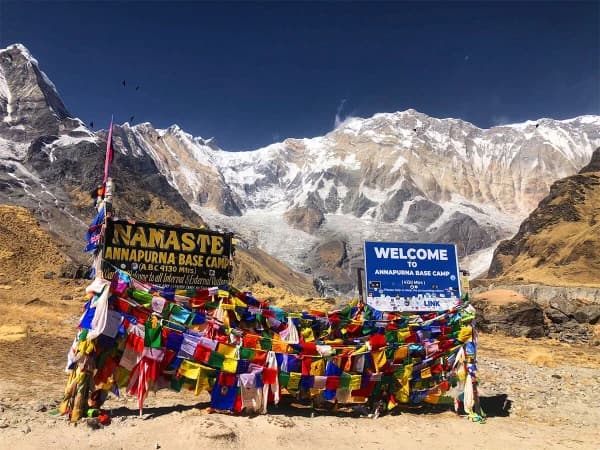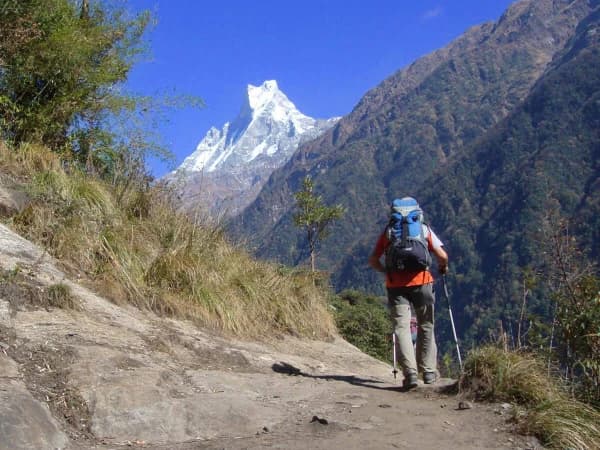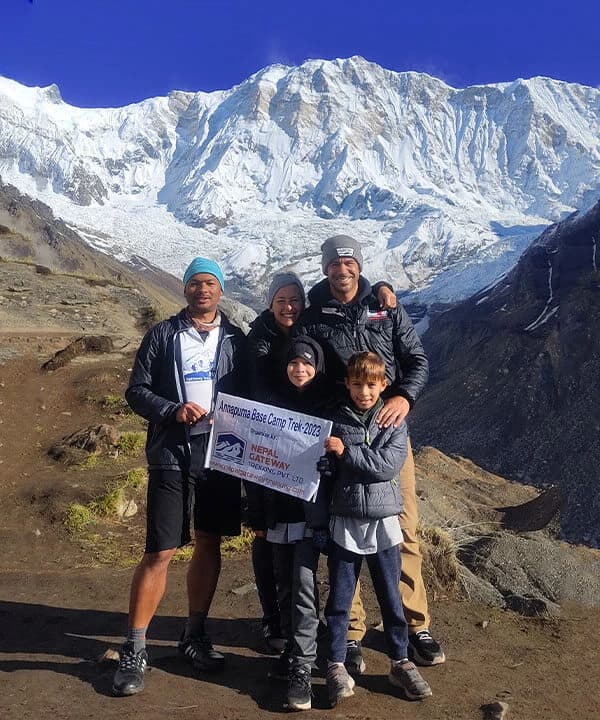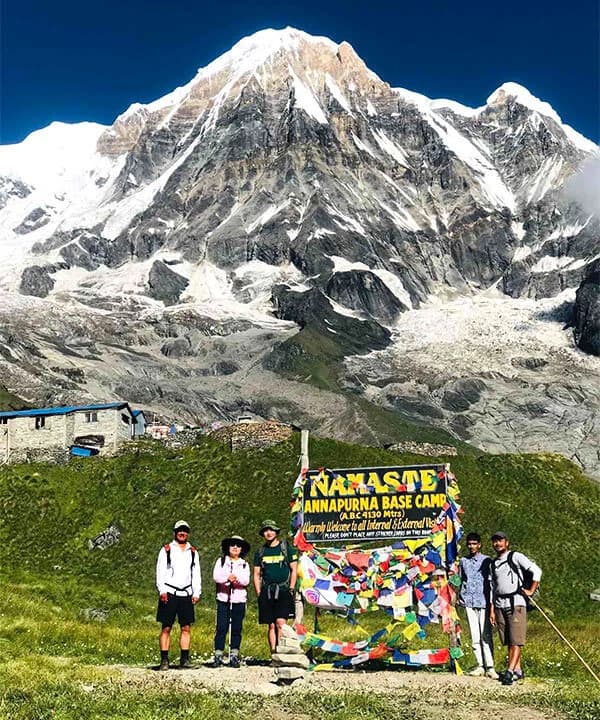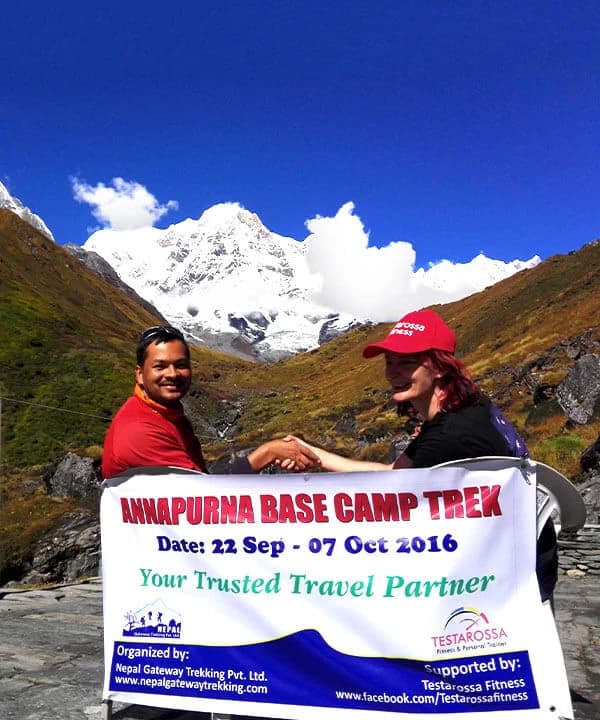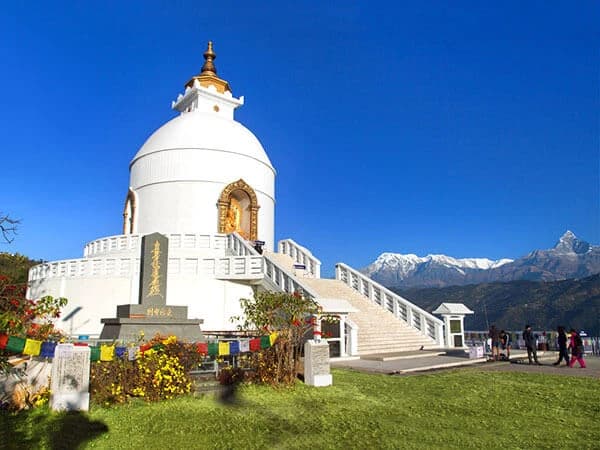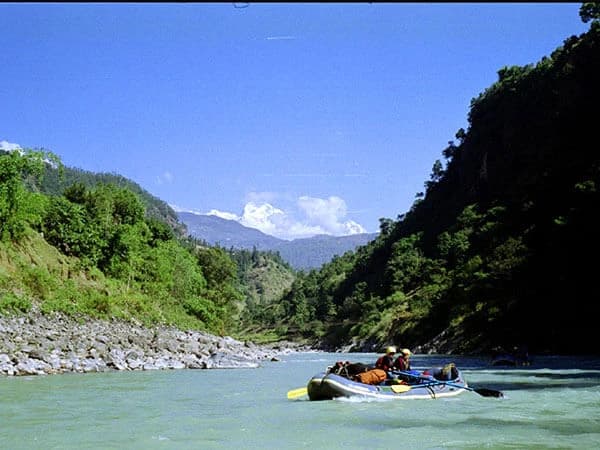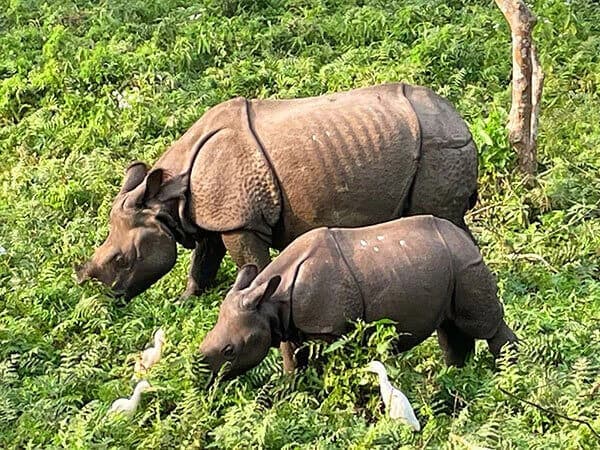Are you considering being at the base camp of Annapurna I in the short time frame? Then, embark and join our short Annapurna Base Camp Trek.
Short Annapurna Base Camp Trek
Short Annapurna Base Camp Trek is one of the most popular walks in the Himalayas of Nepal. The 10-day itinerary offers natural and cultural diversity with breathtaking mountain vistas. The picturesque Gurung villages, serene rivers, raging waterfalls, and rare wildlife are the highlights of this short trek.
Annapurna I, towering at 8,091 meters, is the 10th-highest mountain in the world. On June 3, 1950, this mountain became the site of a historic achievement when a French expedition team led by Maurice Herzog reached its summit, making it the first successful ascent of an 8,000-meter peak. This remarkable feat was achieved three years before Tenzing Norgay and Sir Edmund Hillary conquered Mt. Everest (on 29 May 1953).
Unlike other treks, the short ABC Trek takes you to the base camp of not just one but two mountains—Annapurna and Machhapuchhre. Trudging from 820 meters in Pokhara up to 4,130 meters in the Annapurna Base Camp, you’ll experience dramatic variations of landscape and scenery in this trek. You’ll walk through the subtropical forest adorned with rhododendrons and orchids to the amphitheater of the high Himalayas.
This trek provides you with the opportunity to witness the up-close view of some of the world’s highest peaks. From ABC, you witness Annapurna I, Machhapuchhre, Annapurna South, Gangapurna, Hiunchuli, and Annapurna III. The first light of the sun glistening over the snow-capped mountains makes the sunrise view from the base camp one of the best in the world.
As a part of the Annapurna Conservation Area Project, this region is home to some of the most captivating wildlife. The region is home to clouded leopards, Himalayan tahr, musk deer, and Himalayan giant honeybees. Likewise, this is the only region in the world where all six species of Himalayan pheasants are found. Birds like the bearded vulture, wood snipe, hoary-throated barwing, spectacled finch, pygmy flycatcher, and slender-billed scimitar babbler are common in the skies of this region.
The Major Highlights of Short Annapurna Base Camp Trek
- Opportunity to stand at two different base camps—Annapurna South Base Camp and Machhapuchhre Base Camp.
- Relish the up-close view of Machhapuchhre, Annapurna South, Hiunchuli, Gangapurna, Annapurna I, and Annapurna III.
- Enjoy the best sunrise of your lifetime, rising over the Annapurna range from the base camp.
- Witness several high waterfalls raging down from the top of the hills.
- Immerse yourself in the rustic lifestyle and culture of the Gurungs in Chhomrong.
- Hike through the rhododendron forest in full bloom during the spring season.
- Explore the bustling lakeside streets of Pokhara and relax on the shore of Phewa Lake.
Short Annapurna Base Camp Route Overview
The journey of the short Annapurna Base Camp Trek begins with a memorable 7-hour drive from Kathmandu to Pokhara. The following day, you’ll catch a 45-minute ride from Pokhara to reach the trailhead at Phedi. You’ll start the walk from Phedi through the forested trail to arrive at Tolka for your first overnight stay.
In the next couple of days, you’ll walk past the quaint villages of the Annapurna region. You'll pass through Chhomrong, Sinuwa, Bamboo, Dovan, Himalaya, and Deurali to reach the Machhapuchhre Base Camp at 3,700 meters. You start the walk pre-dawn the next morning and hike to the Annapurna South Base Camp at 4,130 meters.
After relishing the awe-inspiring vistas of the mountains, you retrace your route to Jhinu Danda. From here, you’ll catch a jeep back to Pokhara. You’ll conclude the 10-day Annapurna Base Camp Trek with a scenic drive back to Kathmandu.
Why choose short Annapurna Base Camp trekking with Nepal Gateway Trekking?
- Enjoy a hassle-free adventure as our team handles the entire trek logistics, including accommodation, transportation, itinerary, trekking permits, and meals.
- Experienced team of guides, sherpas, and porters to ensure better route navigation and insightful briefings on every aspect of the Annapurna Sanctuary.
- Meet comprehensive safety standards with an advanced first-aid kit, a well-paced itinerary, and emergency protocols.
- Comfortable stay at 3-star accommodation in Kathmandu and Pokhara on a BB basis. On the trek, we’ll handpick the best local teahouses of the Annapurna Sanctuary on a full-board basis.
- Practice sustainability and waste management to impact the local community and environment positively.
- Free Nepal Gateway trekking duffel bag and t-shirt.
Itinerary
This is our standard and recommended Short Annapurna Base Camp Trek Itinerary.
On this day, a representative of Nepal Gateway Trekking will pick you up from the arrival terminal of the Tribhuvan International Airport (TIA) in Kathmandu. He’ll then transfer you to Woodapple Hotel and Spa in Thamel and help you with the check-in procedures.
You’ll have a free afternoon to take showers, eat, rest, and recover from the jet lag. In the evening, your trekking guide will meet you at the hotel lobby for a team introduction and informal trip briefing on the short Annapurna Base Camp Trek.
After the trip briefing, your trekking guide will thoroughly check your apparel and gear to ensure you’ve packed all the essentials for the trek.
On this day, your trekking guide will meet you at the hotel lobby after breakfast, around 06:00 AM. You’ll take a short walk to the tourist bus station in Sorakhutte, about 5 minutes from the hotel. Here, you’ll board a luxury tourist bus and set off for roughly 7 hours to the lake city of Pokhara.
Peek out the bus window and enjoy the beautiful scenery of the rivers, streams, local bazaars, hills, and surrounding mountains. This scenic drive also offers a unique outlook on the rustic lifestyle of the Nepali countryside.
After a rough, long drive, you’ll reach Pokhara around 03:00 PM. Once you check in at the hotel, you can take a quick shower and rest for a while. You’ll have a free evening to stroll around the streets of Lakeside and relax on the shore of Phewa Lake.
Note: The Prithvi Highway (Naubise to Prithvi Chowk) is being expanded. As a result, high traffic congestion is expected in a few sections of the highway. Besides, there will be occasional bumps and dust clouds due to bad road conditions.
After breakfast, you’ll drive around 30 minutes in a private vehicle from Pokhara to reach the trailhead at Phedi. At the trailhead, your trekking guide will conduct a short briefing regarding the route and pacing techniques.
From Phedi, you’ll begin the walk on steep stone-built staircases, passing through the dense forests and occasional rice fields. After 3 hours of gradual climb, you’ll reach the traditional Gurung settlement of Dhampus. This picturesque village offers a breathtaking panorama of the Machhapuchhre and Annapurna ranges.
Only a few kilometers from Dhampus, you’ll make a quick stop at the Tourist Checkpoint in Pothana to verify your ACAP and TIMS permit. As you continue the walk, you’ll enter a thick forest that gradually climbs on stone steps towards Pitam Deurali.
The final section of the day is a gradual descent from Pitam Deurali to Tolka.
Heading out of Tolka, the stunning view of Machhapuchhre will greet you as you follow the downhill trail to the village of Landruk. You’ll gradually descend towards the riverbank and cross the newly-built Ghandruk-Landruk Bridge over the Modi Khola.
As you cross the bridge, the narrow trail soon turns into a wide, beaten jeep track on the way to Jhinu Danda. You’ll cross a 287-meter-long steel suspension bridge at Jhinu Danda and stop for lunch at one of the teahouses.
The final stretch after lunch will be the most challenging section of the day. The walk from Jhinu Danda to Chhomrong is a steep, non-stop climb of nearly 2 hours.
Chhomrong is one of the most popular overnight stops of the Annapurna Base Camp Trek. This small settlement is clustered with teahouses, cafes, local shops, and traditional households. You can relish a close-up view of Annapurna South, Hiunchuli, and Machhapuchhre from Chhomrong.
You’ll begin the day by entering the Tourist Checkpoint in Chhomrong to validate your ACAP and TIMS permits. From here, the trail drops steeply on the stone staircases towards Chhomrong Khola. You’ll cross another small steel suspension bridge and gently climb toward the tiny settlement of Tilche.
From Tilche, the trail ascends rather steeply through bamboo and rhododendron forests to the ridge crest at Upper Sinuwa. After a short break, you’ll continue through the forest, contouring the edge of the cliff to reach Khuldighar. Keep your eyes open as the forest section from Sinuwa to Khuldighar is an excellent spot to encounter wild animals, including musk deer, Himalayan tahrs, and langurs.
The trail descends through narrow stone staircases on the cliffside towards the village of Bamboo. From Bamboo, you’ll gradually climb for about an hour to arrive at your overnight destination — Dovan. Step out of your teahouse and enjoy the up-close view of the peak of Machhapuchhre from Dovan.
After breakfast, you’ll begin an hour-long uphill climb towards the Himalaya Hotel through the thick bamboo and rhododendron forest. Amid the forest, you’ll come across a small temple dedicated to a local deity, Lord Baraha. On the other side, across the river, you’ll see a large waterfall, locally known as Tomrong Jharna, cascading over a massive rock wall.
Upon reaching the Himalaya Hotel, the thick forested trail opens up, extending the marvelous view of the glacial river far below. From here, the trail climbs steeply through the fire-blackened overhang of Hinku Cave and continues towards Deurali.
Beyond Deurali, the valley narrows to a steep-sided ravine on the western bank of Modi Khola as we head towards the avalanche zone. This section is prone to avalanches during winter, often shutting off the regular route. In that case, you must change the course of the route by crossing a small makeshift bridge over Modi Khola and walking on the east bank to pass the avalanche before returning to the regular route.
The walk from Deurali to Machhapuchhre Base Camp is relatively strenuous. Upon reaching Machhapuchhre Base Camp, you’ll get a glimpse of Machhapuchhre, Hiunchuli, Annapurna South, Gangapurna, Annapurna I, and Annapurna III.
On this day, you’ll wake up before dawn and hike to Annapurna Base Camp around 5:00 AM. So, dress warm and hike slowly to let your body naturally adapt to the increasing elevation.
Heading out of Machhapuchhre Base Camp, the trail gradually climbs on a rugged, rocky path as you enter the Annapurna Sanctuary. Soon, the towering mountain peaks encircle you from all directions, making a natural amphitheater. After two hours of gradual climb, you’ll reach Annapurna Base Camp.
You can enjoy the majestic close-up view of Annapurna I and III, Machhapuchhre, Annapurna South, and Hiunchuli from the Annapurna Base Camp. Besides that, you can relish one of the best sunrises of your lifetime, glistening the golden shades over the Himalayas.
After enjoying the view and taking photographs, return to your teahouse in Machhapuchhre Base Camp. Take a short tea break, pack your bags, and retrace your route via Deurali and Himalaya Hotel to settle in at Dovan.
You’ll start the day with a hearty breakfast in the teahouse at Dovan. Heading out of Dovan, you’ll enter the dense forest on the way to Bamboo. The trail climbs abruptly on the stone-built staircases until Khuldighar before descending towards the settlement of Sinuwa.
You’ll stop at one of the lodges in Sinuwa and have lunch. After lunch, you’ll drop steeply to Chommrong Khola, cross a steel suspension bridge, and climb hour-long stone staircases leading to Chhomrong.
After climbing up and out of Chhomrong, the trail drops steeply down to Jhinu Danda. You’ll cross the long suspension bridge and head towards the jeep stand to catch a ride to Pokhara. You’ll bid farewell to the trekking crew before driving off from Jhinu Danda.
The first section of the drive is rough and bumpy. Once you cross Siwai, the ride is much more comfortable and smooth until Pokhara, where you’ll stay in a comfortable hotel near Phewa Lake. You’ll have a leisurely evening to wander around Lakeside or lay back on the shore of Phewa Lake.
Wake up with the scenic vistas of Phewa Lake and surrounding mountains. After breakfast at the hotel, head towards the Tourist Bus Park in Pokhara, where you’ll board a luxury tourist bus to Kathmandu. On the 7-hour-long drive via the Prithvi Highway, you’ll witness beautiful countryside scenery dominated by lush greenery, hills and mountains, local bazaars, and raging rivers.
After 7-hours of frequent bumps, dust clouds, and switchbacks, you’ll arrive in Kathmandu. Your trekking guide will transfer you to your respective hotel in Thamel. After checking in, you can take a much-needed shower, clean up, and get some rest to recover from the long drive.
In the evening, you’ll have the opportunity to wander around the streets of Thamel, offering a mosaic of local shops, restaurants, cafes, and food markets. You can buy Nepali handicrafts and souvenirs for your family and friends back home and enjoy your final evening in Kathmandu.
Your short Annapurna Base Camp Trek ends after breakfast at the hotel. It is time to pack your bags, check out of the hotel, and fly back home. Our representative will show up at the lobby and help you with the check-out procedure. He will then provide a private transfer to Tribhuvan International Airport for your final departure.
If you want to extend your holiday in Nepal, contact our office via email or phone and make the necessary arrangements.
Note: Your hotel pickup will be scheduled three and a half hours before international departure.
Dates & Availability
Private tripCost Includes
- All ground transportation as per itinerary, including complimentary airport pickups and drops.
- Two nights’ accommodation at a three-star hotel in Kathmandu, inclusive of breakfast.
- Two nights’ accommodation in Pokhara, inclusive of breakfast.
- Three meals (breakfast, lunch, and dinner) in the short ABC trek.
- Twin sharing rooms and dormitory accommodations during the trekking.
- One highly experienced, English-speaking, friendly trekking guide.
- Required porters (1 porter between 2 trekkers). A porter is not included for solo trekkers.
- Annapurna Conservation Area Project permit and TIMS card. Please bring two passport-size photos.
- Annapurna Base Camp Trekking Map.
- Nepal Gateway Company T-shirt.
- Nepal Gateway Trekking Company duffle bags for trekking.
- Local fresh fruits (apples, oranges, and pomegranates) for desserts after dinner.
- First aid kit with oximeter.
- Evacuation assistance, if needed.
- All government taxes.
- Office service charge.
Cost Excludes
- Lunches and dinners in Kathmandu and Pokhara.
- Your travel insurance.
- Nepal Visa fees.
- Your international flight ticket to/from Kathmandu.
- Your personal nature expenses, equipment, and medical kit.
- All kinds of hot and cold drinks and alcoholic beverages are available in trekking.
- Hot shower, internet, and phone call unless it is free.
- Battery charging fees for mobile, camera, and other electronic devices.
- Tipping to field staff (tipping is not mandatory but expected).
- Extra accommodations in Kathmandu and Pokhara.
Good To Know
Short Annapurna Base Camp Trek Cost for 2025
The short Annapurna Base Camp Trek is highly affordable compared to other high-altitude treks in Nepal. The standard short Annapurna Base Camp Trek cost for 2025 is USD 750 per person.
The 10-day package includes all the essentials, including 3-star accommodation in Kathmandu and Pokhara. The package includes teahouse accommodation in the trek, transportation, permit fees, meals, guide and porter costs, etc. If you have a large group, Nepal Gateway Trekking offers a special group discount price. You'll get USD 60 to USD 120 per person, depending on your group size.
The standard package includes road transportation to and from Pokhara on a tourist coach. For an extra USD 200, you can upgrade this option to private transportation. Additionally, you can also upgrade the two-way transportation to commercial flights for more comfort and luxury. The flight costs USD 105.00 each way per person.
In addition to the package cost, it is advisable to carry a minimum of USD 15 per day for personal expenses. These expenses include hot showers, snacks, extra tea/coffee, bottled water, cold drinks, etc.
Best Time for Short Annapurna Base Camp Trekking
Most people will say autumn and spring are the best seasons for the short Annapurna Base Camp Trekking. It is not entirely wrong to be fair because the weather mostly stays dry, and the skies remain crystal clear during these seasons.
However, you do not have to limit yourself to these two seasons. In fact, the short Annapurna Base Camp is one of the best year-round treks in the Annapurna region of Nepal. Each season brings unique natural elements, making this one of the most popular adventure holidays among avid trekkers.
Autumn (September to November)
Autumn is by far the most popular season to trek the short Annapurna Base Camp. As the monsoon clouds leave their hold during this time of the year, the weather becomes moderate and dry, excellent for long-distance hikes.
As the sky remains clear and blue throughout the day, the mountains and arid landscapes display their full bloom of beauty in autumn. Hence, you can enjoy the mountain panorama from the Annapurna Base Camp at its absolute best.
Although autumn is the perfect season for trekking, the crowded trails can often be distracting for many. You’ll have to deal with a large number of trekkers along the route and teahouses during this time of the year. Due to the limited availability of teahouses along this route, the rooms are often occupied.
Spring (March to May)
The spring season is the most popular time to go trekking at Annapurna Base Camp after autumn. Autumn days usually begin nice and warm, while afternoons progressively bring harsh winds and cloud cover.
Spring is the best season to admire the region’s full spectrum of greenery and colorful flowers. During this time of the year, the trail reflects the vibrant hues of rhododendrons, magnolias, orchids, and other wildflowers.
Like Autumn, trekking in the spring involves somewhat crowded trails and teahouses.
Winter (December to February)
Winter brings harsh weather and extreme cold. The daytime temperatures are often tolerable in the upper reaches of Annapurna Base Camp. The temperature can drop below minus 20°C at night. Likewise, the sections above the Himalaya Hotel are usually bringing constant snowfalls, extreme cold, and harsh snowstorms.
Besides that, there’s a vast avalanche zone between Deurali and Machhapuchhre Base Camp. Generally, the regular trekking route to Annapurna Base Camp will be closed due to frequent avalanches in winter. Although the locals build an alternative route across the river, you must stay cautious while walking through this section.
However, the winter season is the perfect time to trek to Annapurna Base Case for avid trekkers willing to brave the cold. Since the trails are mostly empty during this time, wildlife often comes out on the trails in search of food and sunlight. Therefore, it is an ideal time to get unique wildlife sightings, including Himalayan Tahr, musk deers, langurs, etc.
Monsoon (June to August)
During monsoon season, traffic in the Annapurna Base Camp usually grinds to a halt, making it the least favorable season. However, this season brings new life to the surrounding landscapes, with blooming wildflowers and raging waterfalls down the hills of Annapurna.
Although a challenge, a few determined trekkers brave the adverse weather to experience the vibrant landscape and calmness of the Himalayas.
The monsoon season brings constant rainfall and thunderstorms, resulting in muddy, slippery, and waterlogged trails. The risk of landslides is also significantly higher during this time of the year. Besides, the mountain views are not great during the monsoon due to the constant cloud cover and heavy rain.
What permits are required for Short Annapurna Base Camp Trek?
For Short Annapurna Base Camp Trek, you must obtain an Annapurna Conservation Area Project Permit and TIMS Card.
During the trek, these permits will be checked and verified at the Tourist Checkpoints in Pothana and Chhomrong.
Annapurna Conservation Area Project Permit (ACAP)
Since the short Annapurna Base Camp Trek lies within the Annapurna Conservation Area Project, you require ACAP permit. This ACAP entry permit fee contributes to environmental preservation, social and economic development. The ACAP use the fund for tourism promotion with minimal negative impact within the conservation area.
Where can you get the Annapurna Conservation Area Project Permit (ACAP)?
The ACAP permit can be obtained from the Nepal Tourism Board (NTB) office in Kathmandu/Pokhara. It costs NPR 3,000 per person for foreign travelers and NPR 1,000 per person for SAARC nations.
Trekkers’ Information Management Systems (TIMS)
The TIMS Card is a mandatory trekking permit for the short Annapurna Base Camp Trek. It is introduced in collaboration with the Nepal Tourism Board and TAAN. This permit ensures the safety and security of trekkers, manage their flow, and control illegal trekking operations.
Where can you get the Trekkers’ Information Management Systems (TIMS)?
The TIMS Card can be obtained from the offices of the Nepal Tourism Board or TAAN in Kathmandu and Pokhara. It costs NPR 2,000 for foreign travelers and NPR 1,000 for SAARC nations.
Short Annapurna Base Camp Trekking Difficulty
The short Annapurna Base Camp Trekking is a moderately challenging high-altitude trek. This trek is suitable for all levels and age groups trekkers even beginners. The short ABC trek doesn't require any previous trekking experience although prior high-altitude trekking experience is helpful.
Although this trek doesn’t include any technical sections, a few steep uphills and downhills on uneven terrain can be harsh on your feet. Besides that, the short ABC Trek demands 5 to 7 hours of walking with an average daily. However, it is achievable with a moderate fitness level.
In the 10-day itinerary, you’ll only spend one night above 3,500 meters at Machhapuchhre Base Camp (3,700 meters). Although you’ll reach 4,130 meters at Annapurna Base Camp, you’ll spend less than an hour at that elevation. Hence, the risk of high altitude sickness is considerably less in the short Annapurna Base Camp Trek. You’ll have plenty of time to acclimate and adjust your body to the increasing elevation naturally.
However, if you do this trek in the winter, you’ll have extra setbacks. Unlike regular seasons, the weather tends to get extreme above the Himalaya Hotel. Additionally, the regular route in the avalanche section above Deurali may be closed. In this situation, the trail will be diverted to the other side of the river.
So, you'll have to be very careful while doing a ABC Trek in winter. You should be extra cautious while crossing avalanches section on the trek.
Training for Short ABC Trek
Although the short ABC Trek is not strenuous, a moderate fitness level is recommended to make it comfortable and enjoyable. You must prepare and train properly to be fit enough to hike 5 to 7 hours in a day. You have to mentally prepare yourself for carrying a decent-size backpack on rough terrain and adverse weather.
We highly recommend training at least 6 to 8 weeks before kickstarting your adventure. Here are a few pre-trek training tips to improve your fitness level for the 10-day Short Annapurna Base Camp Trek:
- One of the best ways to train for any trekking adventure is to go for conditioning hikes on the nearby trails. But before you find a trail and start hiking, it is advisable to start with slow and short walks. After a week or two, gradually increase the distance, intensity, and duration of the walks. As you improve, go for full-day hikes at least once a week with a weighted pack to replicate similar conditions.
- For the short Annapurna Base Camp Trek, steady-state cardio or aerobic training is a must. You should engage in cardio exercises like jogging, swimming, rope jumping, rowing, and cycling. You can do cardio exercise at least three to four days a week. Cardio or aerobic workouts help improve cardiovascular fitness, lung capacity, breathing ability, and stamina while reducing joint stress.
- You should add a few exercises to strengthen your core and upper body muscles to improve your balance, strength, posture, and stability. A strong core and upper body can help you carry a decent-size backpack for a long period on uneven surfaces. Core exercises can also help you recover faster and prevent injuries during the trek.
- You should also strengthen your leg muscles for the short Annapurna Base Camp Trek. Strong leg muscles help support the weight of your backpack and allow you to walk through uneven surfaces with more agility, speed, and endurance.
- Although often neglected over strength and cardio exercises, adding regular stretching to your fitness regimen improves your body flexibility and joint mobility. A 30-minute daily stretching exercise also improves blood circulation, aids recovery, prevents injury, and builds mental endurance.
- Training does not necessarily mean lifting, running, or pushing yourself too hard. The secret to better results and performance is adequate rest and recovery. Having at least one rest day a week is crucial to letting your muscles and body recover and repair after regular exercise. Adequate rest helps improve overall performance, restore energy, and prevent burnout.
Acclimatization and Safety
The short Annapurna Base Camp hike involves walking in the high-altitude trails of the Himalayas for over a week. You’ll reach up to 4,130 meters at Annapurna Base Camp and stay overnight at 3,700 meters at Machhapuchhre Base Camp.
So, compared to other high-altitude treks in Nepal, the short Annapurna Base Camp hike possesses minimal risk of acute mountain sickness (AMS). Having said that, you must follow a few simple rules to acclimatize naturally and take necessary measures to prevent it.
Things You Should Do to Acclimatize
- Walk slowly and let your body naturally adjust to the thin air.
- Stay hydrated by drinking at least 3 to 5 liters of fluid every day.
- Alcohol, cigarettes, and other stimulants are known to cause dehydration and fluctuate heart rate and blood pressure. So, avoid such stimulants at all costs throughout the trek.
- Although you’re likely to lose your appetite at high altitudes, you should eat adequately to provide enough nutrients and calories in your body.
- If you feel unwell or have any symptoms of acute mountain sickness, inform your trekking guide immediately so he can evaluate your health condition and take necessary action.
Accommodation during the Short Annapurna Base Camp Hike
You will be accommodated in a 3-star category hotel in Kathmandu and Pokhara. These hotels offer top-class facilities, including spacious rooms with ensuite bathrooms, in-house restaurants, room service, and daily housekeeping service to ensure luxury and comfort.
You’ll stay in the local teahouses for overnight accommodation during the trek. Although one of Nepal’s most commercial trekking regions, most overnight stops (except Chhomrong) in the short Annapurna Base Camp Trek surprisingly have few teahouses.
The National Trust for Nature Conservation (NTNC) monitors the teahouses in the Annapurna region. This organization has set limits on the number of teahouses along this specific route to reduce environmental impact in the conservation area. They also have strict requirements, including standard menus and fixed pricing.
The rooms in the teahouses are pretty cozy, with twin beds, foam mattresses, warm blankets, and comfortable pillows. However, they do not have heating facilities. On colder nights, ask for an extra blanket or use your sleeping bag to keep you warm. Additionally, the teahouses have a shared toilet and shower area.
Note: All accommodations (in Kathmandu, Pokhara, and during the trek) are provided on a twin-shared basis. We can arrange a single supplement upon request for an additional cost. However, due to limited rooms, the single supplement may not always be possible in the upper reaches of the trek.
Meals on Trekking to Short Annapurna Base Camp
During your stay in Kathmandu and Pokhara, our standard package only includes breakfast at the hotel.
On the trek, however, all meals are included in the package—breakfast, lunch, and dinner. Breakfasts and dinners are generally served at the teahouse where you spend the night, and lunches are served en route. These meals often include one hot drink such as tea, coffee, or hot juice.
The food menu in the short Annapurna Base Camp is quite similar to other treks in Nepal, with a combination of Nepali, Indian, and continental dishes. Dal Bhat and Momo are the favorite among the trekkers. Other local delicacies include chowmein, thukpa, fried rice, Tibetan bread, and chapati. Likewise, continental options include pasta, sandwiches, chop suey, pancakes, and macaroni.
The menu also includes a variety of beverages, including teas (milk, ginger, black, lemon, masala, etc.), hot juice, hot lemon, soft drinks, and instant coffee.
Note: If you wish to eat or drink anything besides these meals, you must pay for it yourself.
Drinking Water availability at Short ABC Trek
Tap and boiled water are available in the teahouses of Annapurna Base Camp. However, we do not recommend drinking tap water untreated or unfiltered. Untreated water can cause water-borne diseases such as diarrhea and vomiting, ruining your entire trip.
So, bring a water bottle with a straw filter to filter the tap water. Additionally, chlorine—or iodine-based water purifiers should be used to make the water safe to drink.
Although boiled water is considered safe, we recommend treating it with purification tablets or drops. Generally, teahouses charge a nominal fee for boiled water.
Bottled mineral water is banned in the Annapurna Base Camp Trek to minimize the plastic waste in the Annapurna Conservation Area (ACA).
Hot Shower facilities during Short Annapurna Base Camp Hiking
Hot showers are available in every village en route to the Annapurna Base Camp. Most teahouses in the lower reaches provide gas—or solar-powered hot showers.
However, running hot water is not available on the upper reaches of the trek. So, you’ll have to adjust with buckets of hot water for a quick shower. Hot showers cost USD 2 to 3 in the lower regions and up to USD 6 in the upper areas.
Mobile Network and Internet Connectivity
The lower reaches of the Annapurna Base Camp Trek have decent mobile network coverage for both NTC and Ncell. Although the coverage becomes weak and irregular in the forest area, it works well considering the region’s remoteness.
Beyond Deurali, however, mobile coverage is terrible and non-existent. Recently, NTC has expanded its 4G services at Deurali, MBC, and ABC to facilitate the trekkers. Hopefully, this will solve the connectivity and high-speed internet problem in the upper reaches of this trek.
You can expect 3G data coverage in most villages with decent mobile networks. However, do not expect reliable coverage as the mobile network at this elevation is heavily weather-dependent.
You can get WiFi service in almost every teahouse on the Annapurna Base Camp Trek. While some lodges in the lower region may include WiFi service in the room price, you’ll have to pay a small charge of USD 2 to 5 per device in the upper area. However, due to the remoteness and lack of accessibility, the WiFi connection can often be poor and infrequent.
Electricity on Trek to Short Annapurna Base Camp
Electricity is available throughout the route of the trek to short Annapurna Base Camp. While most villages in the lower section are powered by hydroelectricity, a few in the upper section still rely on solar power. So, you can charge your phones and electronic devices without any problem.
The rooms do not have charging sockets. Instead, the teahouses have a shared charging station in the dining area. In the peak season, the charging stations are mostly packed, so charge your devices as soon as you reach the teahouse.
There will be a nominal cost to charge your electronic devices, which increases as you go higher on the trek. Additionally, we recommend carrying a high-capacity power bank for emergencies.
ATMs and Money Exchange
You must carry extra cash for personal expenses in the short Annapurna Base Camp Trek. While a few teahouses and local shops in the lower region accept foreign currencies, most only accept Nepalese rupees (NPR). So, exchanging your foreign currency before heading to the mountains is advisable.
There are plenty of ATMs and money exchange centers in Kathmandu and Pokhara. We highly recommend you exchange your currency in Kathmandu for the best exchange rate.
The same goes for ATMs. If you need to withdraw some cash, do so in the ATM lounges of Kathmandu or Pokhara.
Travel Insurance for Short ABC Trekking
Although the short ABC Trekking is regarded as moderate, it involves walking on high-altitude, uneven terrain for several days. Moreover, you’ll spend a night over 3,500 meters and reach up to 4,130 meters in the 10-day itinerary.
Hence, this trek holds a risk of acute mountain sickness, physical injuries, accidents, etc. Once you sign up for this trek with Nepal Gateway Trekking, you should get a travel insurance policy mandatorily.
Here are a few things you should consider while buying travel insurance for the short Annapurna Base Camp Trek.
- It covers an altitude of 4,500 meters so that you can reach up to 4,130 meters at Annapurna Base Camp.
- It covers the cost of emergency helicopter evacuation or ambulance to the nearest medical facility.
- It provides hospital and medical coverage for general treatment, physical injuries, and altitude sickness.
- It reimburses prepaid travel expenses and flight change fees in case of trip cancellation.
- It covers the cost of stolen or lost items during the trek.
Guide and Porter Information
At Nepal Gateway Trekking, we pride ourselves on ensuring that all our treks and expeditions are led by highly skilled guides and dedicated porters. We handpick all our guides and crew members for their extensive knowledge and experience in operating trips and expeditions in the high Himalayas.
For the short Annapurna Base Camp Trek, we’ll provide an English-speaking guide who can share valuable insights about the region’s geography, history, culture, and wildlife.
Our guides are wilderness first-aid certified and trained to handle emergencies, including altitude sickness, accidents, etc. They’ll also provide proper guidance on pacing and hydration according to the elevation and terrain.
Additionally, we ensure that our guides and porters are treated fairly as an integral part of our team. They are paid above industry standards and are provided with proper gear.
Gratitude to the Trekking Crew
The trekking guide and the support crew are the unsung heroes who work effortlessly to make your short Annapurna Base Camp Trek successful. Here are a few ways to express your gratitude for their hard work and dedication:
- Tipping is not mandatory in Nepal. But it is an excellent way to express your appreciation for their valuable service and support their livelihood.
- Another way to show your appreciation is by offering gifts and donations. You can donate used clothes, accessories, hiking boots, etc., or buy new ones as gifts.
- You can invite them to dinner on your last day in Pokhara and celebrate the trek’s success together.
- Write positive reviews on platforms like Google Reviews or TripAdvisor so others can contact them in the future.
FAQs
The Short Annapurna Base Camp (ABC) Trek is a popular 10-day itinerary in the Himalayas of Nepal, offering a diverse experience of natural beauty and local culture. It features picturesque Gurung villages, serene rivers, raging waterfalls, rare wildlife, and breathtaking mountain vistas, including two base camps: Annapurna and Machhapuchhre.
The Short Annapurna Base Camp Trek is a 7 to 10-day journey. It typically starts with a drive from Kathmandu to Pokhara, followed by a ride to the trailhead at Phedi. The trek progresses through various villages like Chhomrong, Sinuwa, Bamboo, Dovan, Himalaya, and Deurali, leading to Machhapuchhre Base Camp (3,700m) and then Annapurna Base Camp (4,130m). After enjoying the views, the return journey retraces the route to Jhinu Danda, from where a jeep takes you back to Pokhara, concluding with a drive back to Kathmandu.
Key highlights include the opportunity to stand at both Annapurna South Base Camp and Machhapuchhre Base Camp, enjoying close-up views of peaks like Annapurna I, Machhapuchhre, Annapurna South, Gangapurna, Hiunchuli, and Annapurna III. Trekkers can witness a stunning sunrise over the Annapurna range, see numerous high waterfalls, experience the Gurung culture in Chhomrong, hike through rhododendron forests (especially vibrant in spring), and explore Pokhara.
The standard cost for the Short Annapurna Base Camp Trek in 2025/2026 is USD 750 per person. This 10-day package includes 3-star accommodation in Kathmandu and Pokhara (BB basis), teahouse accommodation during the trek (full-board basis), transportation, permit fees, meals on the trek, and guide/porter costs. Group discounts are available, and transportation upgrades (private vehicle or flights) can be arranged for an additional fee. It is advisable to carry a minimum of USD 15 per day for personal expenses.
While autumn (September to November) and spring (March to May) are generally considered the best due to dry weather and clear skies, the Short Annapurna Base Camp Trek is a year-round destination. Autumn offers optimal mountain views, but the trails are crowded. Spring brings vibrant rhododendron blooms. Winter (December to February) offers solitude and wildlife sightings, but it also brings extreme cold and potential avalanche risks. Monsoon (June to August) presents lush landscapes and raging waterfalls, though with constant rainfall, muddy trails, and limited mountain views.
The Short Annapurna Base Camp Trek is considered moderately challenging and suitable for all levels, including beginners. Although no technical sections are involved, the task requires walking 5 to 7 hours daily on uneven terrain. A moderate fitness level is recommended, and pre-trek training (6-8 weeks) focusing on conditioning hikes, cardio, strength training (core, upper body, legs), and stretching is advised. The risk of acute mountain sickness (AMS) is considerably less due to spending only one night above 3,500m.
In Kathmandu and Pokhara, you will stay in 3-star hotels with top-class facilities. During the trek, accommodation is in local teahouses, typically offering cozy rooms with twin beds, foam mattresses, and shared toilet/shower facilities. All accommodations are on a twin-shared basis, with single supplements available upon request (subject to availability).
Meals in Kathmandu and Pokhara include breakfast only. On the trek, all meals (breakfast, lunch, dinner) are included, featuring a mix of Nepali, Indian, and continental dishes. Dal Bhat and Momo are popular choices, alongside various beverages.
Tap and boiled water are available at teahouses. It is recommended to treat tap water with a straw filter, chlorine, or iodine-based purifiers. Boiled water is also available for a nominal fee, and it's advisable to purify it further. Bottled mineral water is banned in the Annapurna Conservation Area to minimize plastic waste. Hot showers are available in every village. In lower reaches, gas- or solar-powered hot showers are common, while in upper reaches, hot water is provided in buckets for a fee (USD 2-3).
The trek has a low risk of AMS, but trekkers are advised to walk slowly, stay hydrated (3-5 liters of fluid daily), avoid alcohol/cigarettes, and eat adequately. If any symptoms of AMS occur, the trekking guide should be informed immediately. Nepal Gateway Trekking ensures safety with an experienced team, advanced first-aid kits, a well-paced itinerary, and emergency protocols, along with practicing sustainability and waste management.
No prior trekking experience is required for the Short Annapurna Base Camp Trek.It is suitable for all levels and age groups, although a moderate fitness level is recommended.
Yes, travel insurance is mandatory and should cover altitudes up to 4,500 meters, emergency evacuation, and medical expenses.
Traveler’s Experience with Us?
A group of family and friends trekked to ABC with an outstanding team led by Ramachandra Godar and seconded by Ram Sapkota.
We chose...
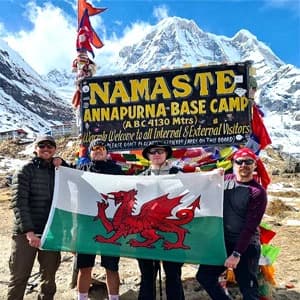
Had a wonderful time at ABC with Ram as a trekking guide. In the beginning, we met Rajendra who helped us on the way and...
